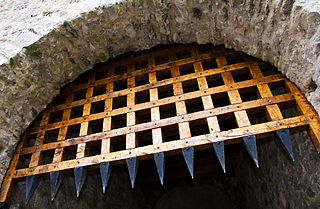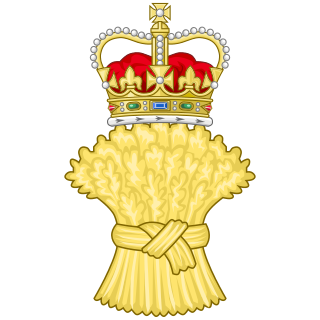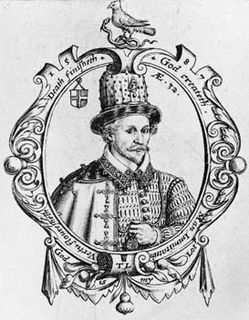
A portcullis is a heavy vertically-closing gate typically found in medieval fortifications, consisting of a latticed grille made of wood, metal, or a combination of the two, which slides down grooves inset within each jamb of the gateway.

A pursuivant or, more correctly, pursuivant of arms, is a junior officer of arms. Most pursuivants are attached to official heraldic authorities, such as the College of Arms in London or the Court of the Lord Lyon in Edinburgh. In the mediaeval era, many great nobles employed their own officers of arms. Today, there still exist some private pursuivants that are not employed by a government authority. In Scotland, for example, several pursuivants of arms have been appointed by Clan Chiefs. These pursuivants of arms look after matters of heraldic and genealogical importance for clan members.

Sir Albert William Woods was an English officer of arms, who served as Garter Principal King of Arms from 1869 to 1904. The Woods family has a strong tradition of service at the College of Arms. Albert Woods was the son of Sir William Woods, Garter King of Arms from 1838 until his death in 1842. Likewise, the grandson of Albert Woods was Sir Gerald Woods Wollaston, who also rose to the rank of Garter King of Arms and served there from 1930 until 1944.

Chester Herald of Arms in Ordinary is an officer of arms at the College of Arms in London. The office of Chester Herald dates from the 14th century, and it is reputed that the holder was herald to Edward, Prince of Wales, also known as the Black Prince. In the reign of King Richard II the officer was attached to the Principality of Chester, which was a perquisite of the then Prince of Wales. In the reign of King Henry VIII the title lapsed for a time but, since 1525, the office of Chester has been one of unbroken succession, as a herald in ordinary. The badge of office is taken from the arms of the Earl of Chester and in blazoned as A Garb ensigned of the Royal Crown Or.

Portcullis Pursuivant of Arms in Ordinary is a junior officer of arms at the College of Arms in London. The office is named after the Portcullis chained Or badge of the Beauforts, which was a favourite device of King Henry VII. King Henry's mother was Lady Margaret Beaufort. The office was instituted around 1485, probably at the time of Henry's coronation. The badge of office is very similar to that of Somerset Herald of Arms in Ordinary, the latter being ensigned with the Royal Crown. The earliest recorded Portcullis Pursuivant was James or Jacques Videt, who was the plaintiff in a Common Pleas case in 1498 and again in 1500.

Sir Gilbert Dethick, FSA was a long-serving English officer of arms at the College of Arms in London. He would eventually rise to the highest heraldic office in England and serve as Garter Principal King of Arms.

John Philip Brooke Brooke-Little was an English writer on heraldic subjects, and a long-serving herald at the College of Arms in London. In 1947, while still a student, Brooke-Little founded the Society of Heraldic Antiquaries, now known as the Heraldry Society and recognised as one of the leading learned societies in its field. He served as the society's chairman for 50 years and then as its president from 1997 until his death in 2006.

Sir Alexander Colin ColeFRHSC (Hon) was a long serving officer of arms at the College of Arms in London. Eventually, he would rise to the rank of Garter Principal King of Arms, the highest heraldic office in England.

Sir Anthony Richard Wagner was a long-serving officer of arms at the College of Arms in London. He served as Garter Principal King of Arms before retiring to the post of Clarenceux King of Arms. He was one of the most prolific authors on the subjects of heraldry and genealogy of the 20th century.
Peter Brotherton Spurrier was an officer of arms at the College of Arms in London. He was appointed Portcullis Pursuivant of Arms in Ordinary in 1981 and York Herald of Arms in Ordinary in 1992. He retired from the College of Arms in May 1993.

Sir George Rothe Bellew,, styled The Honourable after 1935, was a long-serving herald at the College of Arms in London. Educated at the University of Oxford, he was appointed Portcullis Pursuivant in 1922. Having been Somerset Herald for 24 years, he was promoted to the office of Garter Principal King of Arms in 1950, the highest heraldic office in England and Wales. He served in that capacity until his resignation in 1961. As Garter, Bellew oversaw the funeral of George VI, proclaimed the late King's daughter, Elizabeth II, as Queen and took a leading role in the organisation of her Coronation in 1953. After his retirement, Bellew was Secretary of the Order of the Garter and Knight Principal of the Imperial Society of Knights Bachelor. He lived for many years at Dower House in Old Windsor, Berkshire, but later moved to Farnham and died in 1993, aged 93.

William Alexander Lindsay was a long-serving officer of arms at the College of Arms in London. Lindsay was the son of Hon. Colin Lindsay son of James 7th Earl of Balcarres, 24th Earl of Crawford and Lady Frances Howard, daughter of the Earl of Wicklow. On 7 May 1870, he married Lady Harriet Hamilton-Gordon, a daughter of the 5th Earl of Aberdeen and Mary Baillie. His heraldic career began in 1882 when he was appointed Portcullis Pursuivant in Ordinary at the College of Arms. He was promoted to the office of Windsor Herald of Arms in Ordinary in 1894. In 1919, he was promoted Norroy King of Arms after Charles Athill was promoted to Clarenceux King of Arms. Three years later, Lindsay followed Athill to the role of Clarenceux on Athill's death. Lindsay held the office from 1922 until his own death in 1926.
Major Charles Murray Kennedy St Clair, 17th Lord Sinclair, CVO, DL was a Scottish peer who spent his entire life in the service of the Crown; as a soldier, an officer of arms, an equerry in the Queen Mother's Household, a representative peer and as a Lord Lieutenant.

Thomas Lant (1554–1601) was a draftsman and long-serving officer of arms at the College of Arms in London. Lant was born in Gloucester and was one of seven children of Thomas and Mary Lant. When Lant was twelve years old, he became a page to Richard Cheney, the Bishop of Gloucester. When Cheney died in 1579, Lant again became a page, this time for Henry Cheney. It was through Lord Cheney that Lant became connected with Sir Philip Sidney. The two accompanied each other to the Low Countries in 1585. Lant was the draftsman of roll recording Sidney's funeral procession at St Paul's on 16 February 1587.

Sir William Segar was a portrait painter and officer of arms to the court of Elizabeth I of England; he became Garter King of Arms under James I.

Robert Cooke was an English Officer of Arms during the reign of Elizabeth I, who rose swiftly through the ranks of the College of Arms to Clarenceux King of Arms, serving in that office from 1567 until his death in 1592–3.

Peter Toms RA was an English portrait and drapery painter, i.e. a painter specialising in depicting drapery for the works of other artists. He was a founding member of the Royal Academy. He was also the Portcullis Pursuivant at the College of Heralds.

William Henry Toms was an English engraver. He worked on portraits, book-plates, landscapes and prints of buildings. Among his works were the plates for Robert West's "Perspective Views of All the Ancient Churches in London" (1736–1739). In 1741, he worked with Thomas Badeslade on "Chorographia Britanniae or a New Set of Maps of all the Counties in England and Wales". The maps were republished on 29 September 1742, with additional place names.
Samuel Thompson was employed by the herald William Segar, before being recommended by William Dethick to be granted a place as a pursuivant, as he was competent in Latin. He was appointed Portcullis pursuivant in 1597. He was promoted to be Windsor herald in 1617. In 1623 he conducted the visitation of Surrey as deputy for William Camden. He had a house in Streatham, where his will was written in May 1624, but asked to be buried in St John Zachary.
Richard Leigh was an English officer of arms. He was created Portcullis Pursuivant in 1571 and in this role conducted visitations of Buckinghamshire, Oxfordshire and Shropshire on behalf of the Clarenceux King of Arms. He was promoted to Richmond Herald in 1592, in which role he conducted the visitation of Lincolnshire. Promoted to Clarenceux in 1594, he inherited his predecessor's dispute with William Dethick over their respective jurisdictions, during which in 1596 he had a copy made of a privy seal grant made by Henry VIII to Thomas Benolt. As Clarenceux he undertook visitations of Berkshire and Northamptonshire, but these were formally completed. He died in September 1597 and was buried at St Alphage London Wall.

















